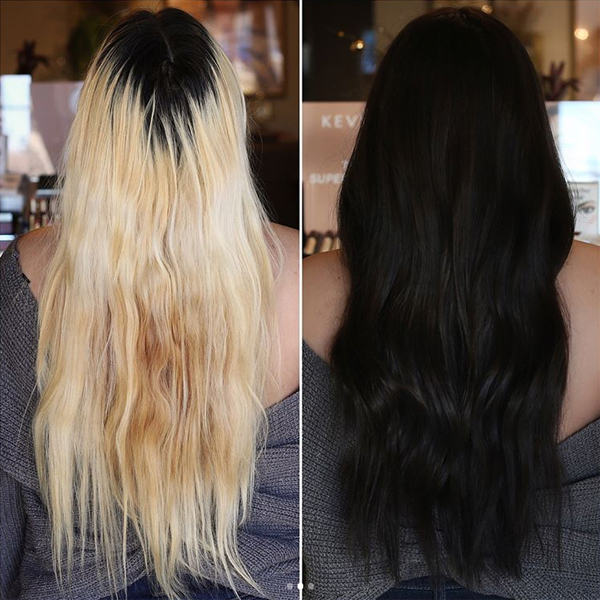One-Step Repigment Technique: The Pigment Lock
Learn More About This One-Step Repigment Technique!
You know that to take blonde hair back to a natural dark shade, you must fill the hair, and you also know that this two-step technique—called a tintback or repigmenting the hair—results in warmer hues. But what if you want to take a blonde back to a natural cool brunette? Tintback 101—you can’t use cool hues to fill (you’ll get a muddy green!). In this situation, try the pigment lock! We got the deets on this master-level color technique from Wella Professionals Signature Studio Artist Danielle Stern (@danielle_wella) when we stopped by a color correction class at the Wella World Studio in NYC. Check it out!
(Psst…click here to get the basics on repigmenting hair!)
When To Use A Pigment Lock Technique
“I use this technique when someone REALLY light is looking for the most natural brunette finish,” Danielle said. With a pigment lock, you can take a client from light to dark without repigmenting, and it won’t alter the client’s natural root shade. Use a pigment lock when:
- Going darker by two levels or more
- A cooler tone is desired

How To Perform A Pigment Lock
Danielle’s expert tip is to mix this formula one level darker than desired. Here’s how to do it (and yes, you are reading this right…there is no developer in the initial formula!):
Formula
15g Wella Professionals Koleston Perfect /77 (any shade in the /77 range, which Danielle described as “brunette tones, rich and warm”)
15g Koleston Perfect /0 (any shade in the Pure Natural range, one level darker than desired)
90g warm water
- Apply the pigment lock formula on dry hair and leave on for 15 to 20 minutes. Do not rinse.
- Apply 120g Koleston Perfect Pastel Crème Developer over the pigment lock. Process for 20 to 30 minutes.
- Rinse, do not shampoo, and follow with Wella Professionals Post Treatment.
Products Used
Why A Pigment Lock Works
- The first step—applying the pigment and water—allows the color molecules to penetrate the hair shaft in their smallest size.
- The second step—adding the developer to begin oxidation—locks the color into the hair shaft.
Check out Wella Professionals classes here, and learn more about the Wella Professionals Master Color Expert Program here!
Listen to the video below for Danielle’s explanation!
The Pigment Lock In Action
Scroll through the slideshow to see before-and-after shots using the pigment lock technique.
Check out the at-the-bowl application by @cameronkepford!

More from
Wella Professionals
-
Monthly Product Launch List
11 New Game-Changing Hair Launches To Add To Your Arsenal
-
Industry News
Wella Professionals Announces the “PROject the Now” Challenge Winners
-
Manufacturer Events
“The He(ART) of Hair”: Wella Company Names & Celebrates Beauty Envision Award Winners
-
Hair Color
Bold Color Trends You Need To Know For 2024
-
Glossing/ Toning
Clear Gloss Guide: 5 Ways To Build Your Ticket
-
Glossing/ Toning
Coral Crush
-
Blonde
6 Blonding Techniques To Save Your Client’s Hair
-
Bobs
The Biggest Haircut Trends of Summer 2023
-
Balayage
Your Official Guide To Barbie Blonde
-
Business
15 FREE Classes To Take For Hairstylist Appreciation Week
-
BTC Hair Trend Report
Your Complete Guide To Color Blocking
-
BTC Hair Trend Report
Chocolate Copper
-
Blonde
Warm Honey Bronde
-
Blonde
How To Formulate Toners For Honey Blonde
-
BTC Hair Trend Report
2023 Hairstyling: 11 Trends You Need To Know
-
Balayage
HONEY BLONDE CURL FORMULA
-
Best Of 2022
10 Toning Tips You’ll Need in 2023
-
Industry Events
Wella Company Celebrates Women Leaders In Founders’ Forum Panel
-
Clarifying
3 Steps To Properly Cleanse Curls & Coils
-
Clarifying
Aqua Pure Purifying Shampoo
-
Conditioners
NUTRICURLS Deep Conditioning Treatment
-
Celebrity
Juno Temple’s Grunge Blowout
-
#ONESHOT HAIR AWARDS
Libertas
-
#ONESHOT HAIR AWARDS
The BTC Show 2022: 10 Things We Saw










